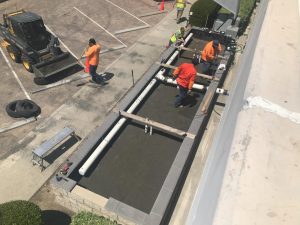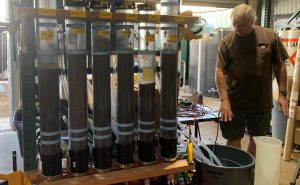Mechanistic study to open stormwater BMP ‘black box’

SCCWRP and its partners have launched a three-year study to characterize the mechanistic inner processes by which a ubiquitous class of stormwater BMPs (best management practices) removes common types of stormwater pollutants as runoff flows through them – an investigation that has the potential to open the “black box” for how these systems work and how managers can optimize their long-term performance.
The project, which kicked off in June with separate presentations to State Water Resources Control Board staff and the Southern California Stormwater Monitoring Coalition (SMC), will focus on biofiltration BMPs, an engineered system that removes metals, nutrients, and persistent organic pollutants as runoff filters gradually through the system. Typically vegetated, biofiltration BMPs consist of engineered media, plus hydrologic and hydraulic controls.
The mechanistic processes by which BMPs remove contaminants is a “black box” – with researchers routinely measuring the properties of the runoff entering and exiting the BMP, but not fully understanding what happens to this runoff while it is being treated inside the BMP.
Once researchers understand these internal mechanistic processes, they’ll be able to design and maintain BMPs optimized to treat runoff over the long term – particularly valuable given the significant investments Southern California has been making in implementing biofiltration systems and similar types of structural BMPs over the past decade.
Traditionally, stormwater managers have relied on published BMP design guidance manuals to inform how they design, construct and maintain BMPs. But the guidance in these manuals is based on incomplete mechanistic understanding of BMP performance.
The BMP processes and mechanisms study – a joint collaboration between SCCWRP, the State Water Board and the SMC – will probe how measurable properties of biofiltration media, along with a range of hydrologic and hydraulic conditions, influence the systems’ effectiveness at removing pollutants.
Researchers will work to link the physicochemical and biological processes by which pollution removal occurs – including sedimentation, sorption, chemical transformation, and biological degradation – to measurable biofiltration BMP properties. The study will focus on three pollutants: copper, nitrate, and per- and poly-fluoroalkyl substances (PFAS).
Previous studies probing BMP performance have shied away from methodically disentangling the processes and mechanisms that explain why BMPs perform as they do, creating a perpetual “black box” around BMPs that has limited managers’ ability to optimize BMP performance effectiveness.
For example, many past BMP studies have compared the performance of different mixes of commercially available biofiltration media to one another – but none have successfully pinpointed the specific measurable properties of the media that explain why some media mixes perform better than others. Similarly, many studies have sought to optimize BMP designs in a laboratory – but few have attempted to transfer these design specifications into the real world to validate their findings.

The SCCWRP-led study will start with a two-year laboratory-based investigation to control and quantify the mechanistic processes that will be studied, followed by field validation. The study’s goal is to bridge the knowledge gap between what happens in a controlled laboratory setting vs. in highly dynamic environmental conditions in the real world. Local environmental conditions can have a significant influence on how BMPs perform.
This study marks the start of what researchers hope will become a series of studies to more fully open the “black box” around BMPs. The initial three-year investigation will serve as a proof-of-concept that this type of study design can be used to gain mechanistic insights into BMP performance.
For more information, and to propose potential collaboration opportunities, contact Dr. Elizabeth Fassman-Beck.
More news related to: Runoff Water Quality, Southern California Stormwater Monitoring Coalition, Stormwater BMPs, Top News